Linkfest #41: The "Chthulucene", Doom on a Satellite, and The Ethics of Selling a Haunted House
Hello!
It’s time for "the opposite of doomscrolling” — my next Linkfest, in which I offer up the finest nuggets of science, culture and technology that I could pan from the glittering, unceasing creek of the Internet.
If you’re a subscriber, thank you! If not, you can sign up here — it’s a Guardian-style, pay-whatevs-you-want affair; the folks who kick in help keep the Linkfest free for everyone else. (Full archive of issues, including this one, is online free here.)
And: Please share this email with anyone who'd enjoy it.
Let’s begin ...
1) 🔊 Wooden app-alert robots

Behold the “Botties”, a set of tiny wooden robots designed by Swift Creatives, as a soothing alternative to pinging phone alerts.
As Matthew Burgos writes on Designboom …
Instead of making noise or flashing lights like smartphones or smart speakers, these wooden robots by Swift Creatives move quietly and use physical gestures to give alerts. Each of them has its own kind of movement: Beamer tilts its head on the sides, Bot bobs its head up and down and pushes its wooden ear in and out, and Hover rotates and stops at one point.
Each robot has a small body made from soaped or smoked oak wood, a material often used in Danish furniture and crafts. Inside each wooden form are sensors and small software systems that allow the mini robots to react to signals from connected devices. When a notification arrives, – say a message, a reminder, or even when the food delivery has arrived at the doorsteps – the Botties react by tilting their heads, nodding, or moving slightly, and this becomes a quiet form of communication that relies more on visual cues instead of sounds.
To get a sense of how adorable these are, you really have to watch this short video here of them in action. The soft, chunking sound of the wood in motion is lovely: Notifications as ASMR.
I’m a big fan of what Mark Weiser and John Seely Brown called “ambient information” — i.e. devices that broadcast something we need to know, but do so in a quieter, calming way. I first wrote about the concept way back in 2002 for the New York Times Magazine, but it never really took off.
2) 🎲 “Tiled Words” is a blend of crosswords with Tetris

I just stumbled across a very cool new word game — “Tiled Words”, created by Paul Hebert.
It gives you several crossword-like clues, and you have to create all the words by snapping together Tetris-like letter-segments. You can move a tile anywhere you want, and click it to rotate it clockwise.
If you get a word right but have it oriented the wrong way, it’ll color things orange; if you get the word perfectly right — correct word, correct orientation — it goes blue.
I spent a couple minutes with today’s puzzle getting this far …
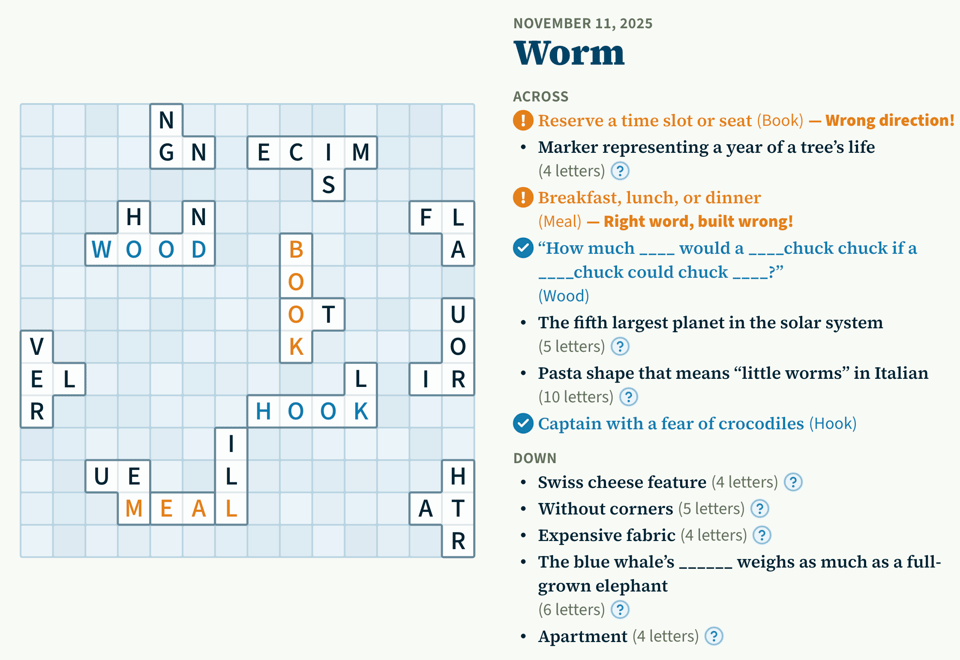
It’s a lot harder than it looks! Every time I assemble a word correctly, it feels like I’ve diced myself out of assembling other words. But I like it — I’m gonna keep working on this one. It’s a very cool game-mechanic!
3) 🎶 Bhutan’s talking stamps
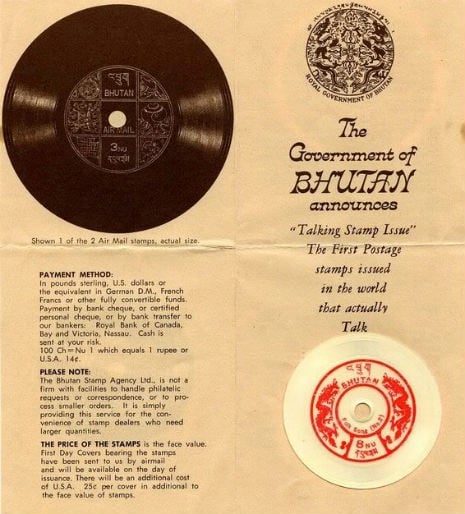
Back in the 1960s, Bhutan issued a set of “talking stamps” — tiny vinyl records that were one-sided: You peeled off backing paper on the non-playing side, and slapped it on an envelope or postcard. Back in 1993 you could buy a mint-collection set for 17 UK pounds, but they’ve since become collector’s items and cost nearly 20 times more.
Their sound is hauntingly low-fi — you can hear one playing Bhutan’s national anthem here at this post on The Vinyl Factory. Eerie!
Weirder yet, they were invented by an American, Burt Todd, who met the future queen of Bhutan when they were both students at Oxford. After she took over she asked Todd to help the cash-strapped country acquire a loan; he couldn’t, so instead he began designing a series of stamps that sold incredibly well, as that The Vinyl Factory post notes …
Todd’s first innovation, in 1966, was a circular stamp marking the 40th anniversary of Dorji-Wangchuk’s coronation, using a heraldic design embossed in gold on rainbow-coloured paper. It sold well. Next up was a series of triangular stamps featuring the yeti, the Himalayas’ fabled abominable-snowman. In 1967 came a set of 3D stamps on the theme of the space exploration; Todd’s stamps showing astronauts and rockets were laminated on prismatic ribbed-plastic and gave a convincing 3D effect. Over 200,000 sets were sold. Other successful issues included a set of Buddhist banners printed on silk, a set of traditional sculptures die-stamped in plastic, perfumed stamps and stamps made out of steel foil.
The talking stamps were the crowning glory of Todd’s programme. The set consisted of a yellow on red design containing a capsule history of Bhutan in Dzongkha, a gold on green with the national anthem, a silver on blue with the history of Bhutan narrated by Todd in English, a silver on purple featuring a folk song, a silver on black with second folk song, a red on white with a third, and a black on yellow containing the English-language history and two of the folk songs.
4) 🐦 Hear birdsong worldwide in the “Dawn Chorus”
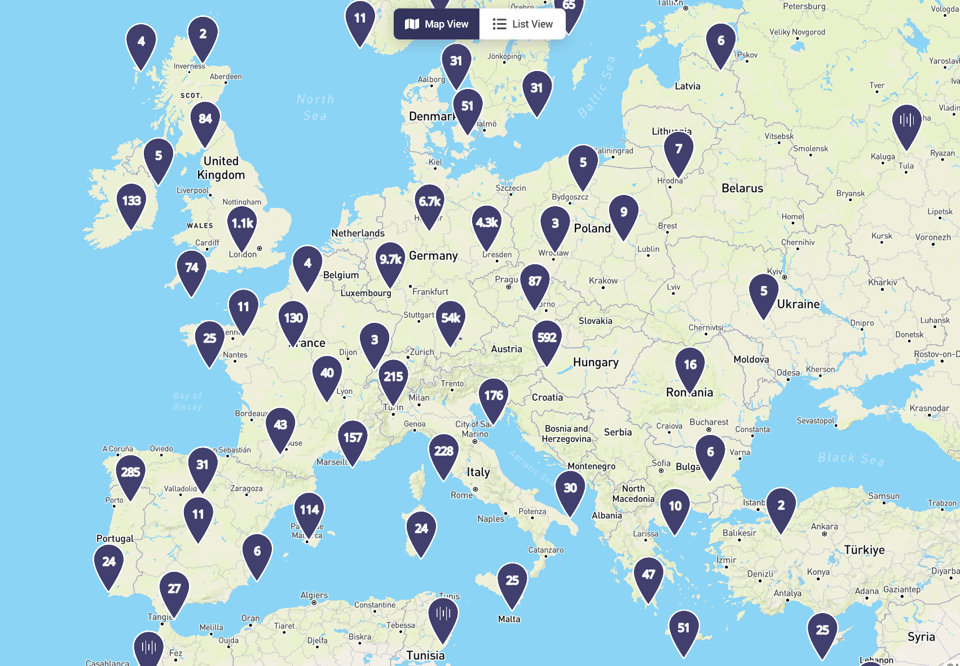
Behold “Dawn Chorus”, a citizen-science project where everyday people record local birdsong and upload it to a web app. Drill down to a specific location and you can hear the sound of birds recorded precisely there.
For example, here’s a Common Blackbird chirping away at 9 am on May 30, 2020, in the town of Peterborough, UK. I spent a half hour poking all over the globe, listening to birds here and there, and it’s really addictive!
The project was created by a consortium of scientists and conservationists in Europe, with the goal of gathering more info about the health of a habitat via birdsong. As they note, birdsong is a powerful indicator …
Many bird species are so-called indicator species as they provide information about different properties of a habitat. Long-term collections of early-morning bird sound recordings can thus help us to detect changes in habitats, for example by telling us where species disappear or appear, or how birds change their behaviour.
… and they’re particularly interested in the morning chorus:
For many bird species, dawn is the crucial time when they sing their songs in a polyphonic early morning concert known as the “dawn chorus.” Behind every bird species that can be heard lies a whole network of biological relationships. Birds are therefore often considered indicator species. The sound recordings of the dawn chorus are therefore not only important for the scientific documentation of existing animal species—they also allow conclusions to be drawn about entire ecosystems.
The communal morning concert probably developed because there is particularly little air movement at this time of day. The night has led to uniform cooling and balanced temperature differences. As long as the sun cannot yet warm individual areas, there is little wind. Under these conditions, the singing carries particularly far. Another theory is that birds use the twilight of dawn for their conspicuous (courtship) songs because they are less visible to some predators at this time.
Their request, if you want to help out, is to record the birdsong many times from the same location at the same time of day, both on weekdays and weekends. And …
Recordings made over a period of years from the same location on approximately the same date and at approximately the same time relative to sunrise are a “jackpot” for researchers.
I’m gonna start recording the backyard birds at dawn, at least on the days when I can haul my butt out of bed that early; I am a night owl, pun intended. Judging by the map, they have lots of contributors in Europe but considerably fewer here in the US where I am.
(I’m interested to see that Bernie Krause is involved in this project. He’s a famous audio producer who first documented how human-made noise was increasingly intruding upon areas of previously pristine nature; I wrote a Wired column way back in 2008 talking to him about his concept of the “biophony”, or, the acoustic ecosystem of animals talking to each other in nature.)
(Thanks to Joseph Stirt for this one!)
5) ✍️ Making a font of your handwriting
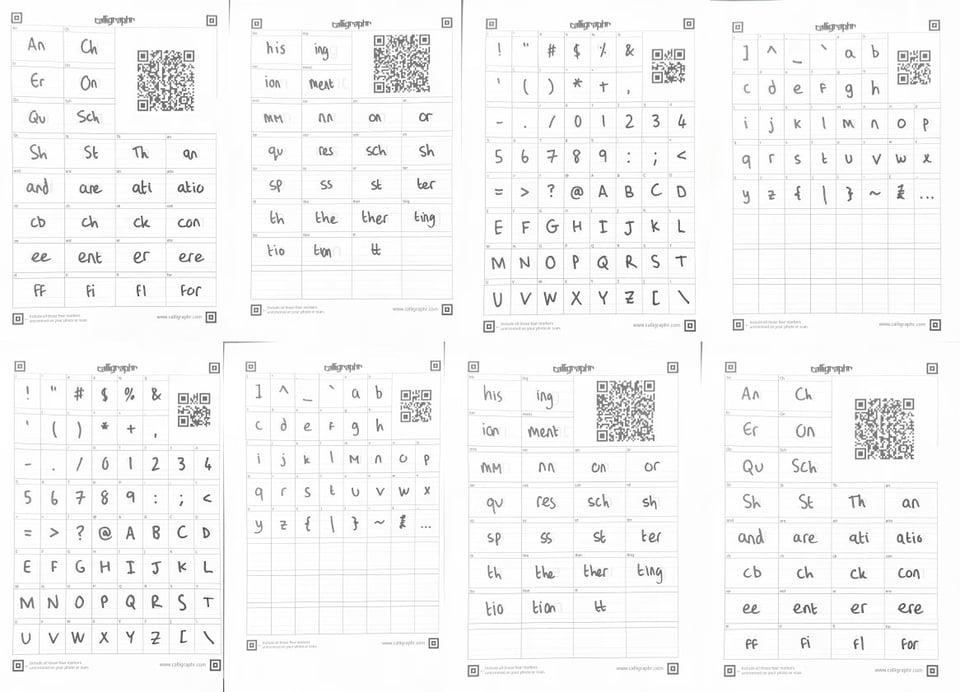
The programmer Chris Smith decided to make a font based on his handwriting, and wrote a terrific post describing how he did it. The tl;dr is that he initially attempted to do it using open-source tools, failed, and then used a very-reasonably-priced service called Calligraphr that made things a lot easier.
It still took a bunch of tweaking …
The first version was not great. Despite the guidelines on the template, I apparently wasn’t good at sticking to them. Some letters were floating way off the baseline, and some were sunken below. When those opposites met it looked terrible. Fortunately Calligraphr has a pretty easy tool to slide each letter up and down, and scale it up or down if needed, and you can see it next to other letters as you do it. It took a little bit of time to go through all the variants of all the letters, but the next version looked a lot better.
Another tweak I ended up doing was reducing the spacing between letters. The defaults Calligraphr uses are probably good for a blocky font, but I wanted to put the letters close together to give it more of a joined-up look. Again, this is an easy tool to use, you just drag the sides in or out as desired. While these tweaking steps were probably as fiddly as some of the Inkscape steps I refused to do earlier, they’re a lot more rewarding as you see things improving with each one. It’s a lot easier for me to commit time and effort to improving something that’s already working reasonably, than put that time and energy into an unknown.
The end result, le voila …

If you go check out that post he wrote, you can see the font in action: He uses it for the section headlines.
This is a fun project, and I would try it, but my handwriting is indescribably bad. I learned to touch-type as a kid way back in 1981, quickly achieved a speed of about 80 WPM, and never looked back. I do write marginalia notes by hand, but can only make ‘em readable if I go very slowly.
6) 🌞 Sea slugs turn themselves into solar panels

Scientists have discovered a type of sea slug that can steal generic material from algae and use it to turn itself into a solar panel.
That is not a sentence that, when I first woke up this morning, I predicted I would be typing! Yet here we are.
Anyway, here’s how it works. The sea slug spends its days eating the algae Vaucheria litorea, which contains millions of “plastids”, or teensy organic components that contain chlorophyll. These chlorophyll-loaded plastids are what allow the algae to generate energy from sunlight.
What the scientists found, though, is that the sea slug can somehow incorporate those plastids into its own body – so successfully, in fact, that it can survive off photosynthesis for up to six months. During those periods, it doesn’t need to eat. It just gets energy from the sun.
As the lead author, Debashish Bhattacharya, notes …
”It’s highly unusual for an animal to behave like a plant and survive solely on photosynthesis.”
You don’t say!
This discovery also has some potentially interesting practical implications:
“The broader implication is in the field of artificial photosynthesis. That is, if we can figure out how the slug maintains stolen, isolated plastids to fix carbon without the plant nucleus, then maybe we can also harness isolated plastids for eternity as green machines to create bioproducts or energy. The existing paradigm is that to make green energy, we need the plant or alga to run the photosynthetic organelle, but the slug shows us that this does not have to be the case.“
7) 🍸 The evolutionary value of getting drunk

I’d recently read some fascinating research showing that monkeys love to get drunk, and occasionally so do birds. So this primed me to be interested in Edward Slingerland’s new book Drunk, which argues that getting sozzled was an evolutionary advantage for humans.
Why exactly would getting tipsy be a good idea? Partly because it helps forge social bonds, as Slingerland tells Jonny Thomson over at Big Think …
First, there is a social aspect to getting drunk. When we drink with someone, we not only have the bonding experience of mutual enjoyment, but also come together in mutual vulnerability. When you are drunk, you’re easy to kill. When you’re staggering home, narrowly avoiding lampposts, it’s easy to steal your phone, your wallet, and your jacket. To be drunk with someone is an act of trust. It says, “I think so much of you that I’m willing to let my guard down.” And so, getting drunk is a kind of “chemical handshake” that lets the other person know you are someone to trust. Societies operate on trust, and alcohol is a kind of “social technology” that builds trust between potentially warring rivals.
Getting a bit drunk can also help with creative breakthroughs, Slingerland says:
“One of the main functions of alcohol is to depress selectively the prefrontal cortex (PFC). It turns the PFC down a few notches and helps us get back to that childlike state of mind where suddenly we see connections we wouldn’t see otherwise. Parts of our brain can talk to each other in ways that they don’t when the PFC is in charge.
And so, let’s say you sit down and you need to come up with a new idea. You have a couple of drinks. You are individually more creative because your brain is now de-patterned in a certain way. Plus, because you’re disinhibited—again, because the PFC has been turned down—you’re more likely to blurt out something to someone else that maybe you would be self-conscious about, or maybe you think it is a dumb idea. You’ll suddenly be like, well, why don’t we try this for getting gazelles?”
I dig this way of looking at it! Then again, considering I’m drinking two fingers of mezcal as I type these very words, I am not an impartial judge of this hypothesis. But I’m definitely ordering Slingerland’s book.
8) 🫨 Most of an earthquake’s energy turns into heat

An earthquake occurs when tectonic plates suddenly slip, which releases a titanic amount of energy: Buildings shake, bridges collapse.
But here’s the nutty thing — apparently all this kinetic activity is just a tiny portion of the energy produced by an earthquake. Most of the energy, up to as much as 98%, turns not into motion but heat.
That’s the conclusion of a fascinating experiment at MIT, where Daniel Ortega-Orroyo and his colleagues created mini-earthquakes in the lab. They made little centimeter-sized wafers out of powdered granite and magnetic particles, and then crushed them between pistons until the waters slipped or snapped. When that breakage finally occurred, they measured the energy output.
Even these centimeter-scale earthquakes got hot fast. “It essentially went from room temperature to above 900 degrees C in a few microseconds—so extremely, extremely fast,” Ortega-Arroyo says.
Between 68 and 98 percent of the energy released in these lab quakes dissipated as heat, the researchers found. The breaking of the wafer took anywhere from less than 1 percent of the energy to as much as 32 percent, whereas the shaking made up 8 percent or less.
This is, weirdly, good news for us humans living up here on the surface of the earth, right? If more of that energy turned into kinetic activity, earthquakes might be far, far more devastating than they already are.
9) 👻 Half of homebuyers think a seller should be legally required to disclose if the house is haunted

I did not realize that YouGov conducts regular surveys of Americans to explore their experiences of the paranormal! But the latest one is out, and it’s full of fascinating and occasionally hilarious results.
I really think you should go read the entire write-up, but the top-line finding is that 60% of Americans say they’ve had some sort of paranormal experience. What type of paranormal experiences, you ask? Well …
The most common paranormal events Americans say they have experienced — among the 13 asked about — are feeling a presence or unknown energy (35%), smelling an unexplained odor (32%), hearing an unexplained sound or music (31%), hearing the voice of someone who wasn’t there (26%), and feeling an unexplained change in temperature (26%).
Not many Americans say they have seen a demon (7%), seen unexplained smoke (9%), or seen an angel (10%).
Also, apparently nearly one in three Americans say they’ve got a paranormal ability:
29% of Americans believe they personally have a paranormal ability. Around one-quarter (23%) say they have the ability to psychically sense others’ emotions or auras. 10% say they have the ability to psychically see events in the future; similar shares say they have the ability to hear voices or sounds from spirits or ghosts (9%) and the ability to psychically see events in the past (9%).
There is a morbidly fascinating exploration of the ethics of selling — and buying — a haunted house:
If a home were affordable and met all of their requirements, 26% of Americans say they would be willing to buy it even if they learned the previous homeowners had been murdered in it. 43% would not buy it in this scenario. Women are more likely than men to say they would not buy a house the previous owners had been murdered in (49% vs. 36%).
About three-quarters (77%) of Americans say that if a murder took place in a house in the past, the homeowner should be legally required to disclose this when selling the house. Women are more likely than men to say this should be legally required (82% vs. 71%).
About half (51%) of Americans say that if a homeowner believes their house is haunted, they should be legally required to disclose this when selling it. Women are more likely than men to say this should be legally required (58% vs. 44%).
10) ⏰️ The “Chthulucene” and the psychology of deep time

It’s hard to get our heads around just how old the Earth is, and how old is life itself.
Some of the first people to wrestle with this were the early 19th-century geologist Charles Lyell, and, a few decades later, Charles Darwin. Lyell had published a textbook arguing that the Earth was billions of years old — a radical idea, given the dominance of Biblical thinking back then — and Darwin relied on those estimates to help him theorize evolution. After all, lifeforms can only evolve gradually if they’re given millions of years to do so.
But these timescales beggar the imagination. Lewis Hyde has written a fascinating essay in Harper’s about Lyell and Darwin’s struggle to grasp the enormity of “deep time”:
Having dispensed with the common belief that the earth was six thousand years old, both men nonetheless often found themselves perplexed about how to speak of the vaster reaches of time they envisioned. In his primary work, the three-volume Principles of Geology, Lyell is regularly vague, speaking of “an indefinite lapse of ages,” “very remote eras,” or “time incalculably remote.” Sometimes he speaks of “millions,” as when he’s arguing against geologists who calculate using thousands of years when “the language of Nature signified millions.” How many millions he rarely says, although his numbers can reach dizzying heights. Truly primordial matters must be figured not just in millions but in “millions of ages,” spans of time wherein all the epochs of geology taken together would “constitute a mere moment of the past, a mere infinitesimal portion of eternity.”
Darwin’s vision of deep time came almost entirely from Lyell. In 1831, at the start of that five-year journey around the world, he carried with him the first volume of Principles and immediately applied its ideas to all he saw. Decades later, in On the Origin of Species, he tells his readers that any who have read Lyell and yet do “not admit how incomprehensibly vast have been the past periods of time, may at once close this volume.” In a typical passage in The Voyage of the Beagle, he writes that “the mind is stupefied” when trying to think on the “lapse of years” needed to produce a two-hundred-mile-wide bed of porphyry pebbles, or that “it makes the head almost giddy” to think of the years required for ocean tides to wear away three hundred feet of solid rock. Such a case, he confesses elsewhere, “impresses my mind almost in the same manner as does the vain endeavour to grapple with the idea of eternity.”
As Hyde notes, this problem of deep time still haunts us, because it lurks behind the challenge of grasping climate change — i.e. the fact that the warming we’re currently seeing is happening far faster than it ought to. You can only really grasp the speed of what’s going on if you grasp the depth of time …
How are we, who plant our corn in spring, who live with four-year election cycles and thirty-year mortgages—how are we to position ourselves in relation to the inhuman forces that have been shaping the earth for four and a half billion years and now seem to be accelerating? How, in short, shall we approach the climate crisis when the needed sense of proportion can be baffled by floods of geological time?
At the end of the essay, Hyde introduces a very cool term — he notes that the feminist scholars Donna Haraway and Isabelle Stengers have argued that we could consider our current geologic period to be the “Chthulucene”, or, the age when the earth responds, quickly and violently, to humanity’s release of so much buried carbon …
“Chthulucene” derives from the Greek khthon, “earth,” and chthonic powers are those associated with volcanoes, earthquakes, caves, and all that lies in the depths below. Greek myths feature dozens of chthonic divinities and forces. Aeacus, a judge of the dead, and Thanatos, winged daemon of death, are chthonic. Hermes in his office as guide of souls is Hermes Chthonios; Persephone in her winter phase is Persephone Chthonia. [snip]
To describe our era as the Chthulucene is to recognize that Gaia is responding to our having released such titanic forces from their confinement. One-hundred-year floods, forest fires the size of nations, record-breaking heat waves: chthonic forces now mess with our affairs as they haven’t since the glaciers last descended from the poles. Surely among the most threatening sources of such powers are the fossil fuels now released from the depths.
An incredibly thought-provoking essay: Go read the whole thing!
11) 🃏 Digital game board that changes its layout

Here’s a Kickstarter for the “Pixply”, a game board that’s digital: It uses an array of LEDs to display the board-designs for 50 traditional games, from chess and backgammon to Ludo and Patolli and dozens of others I’d never heard of.
Interestingly, they say they’re going to include the ability to program your own games. Now this gets interesting, because I’ve long wanted to design a digital board game where the game board layout shifts and changes while you play.
This could allow for some pretty nifty game mechanics, yes? i.e. your player-pieces could suddenly shift from being in a “safe” territory to a dangerous one.
I think I’m gonna have to order one and mess around with this …
12) 💰 The new goldrush
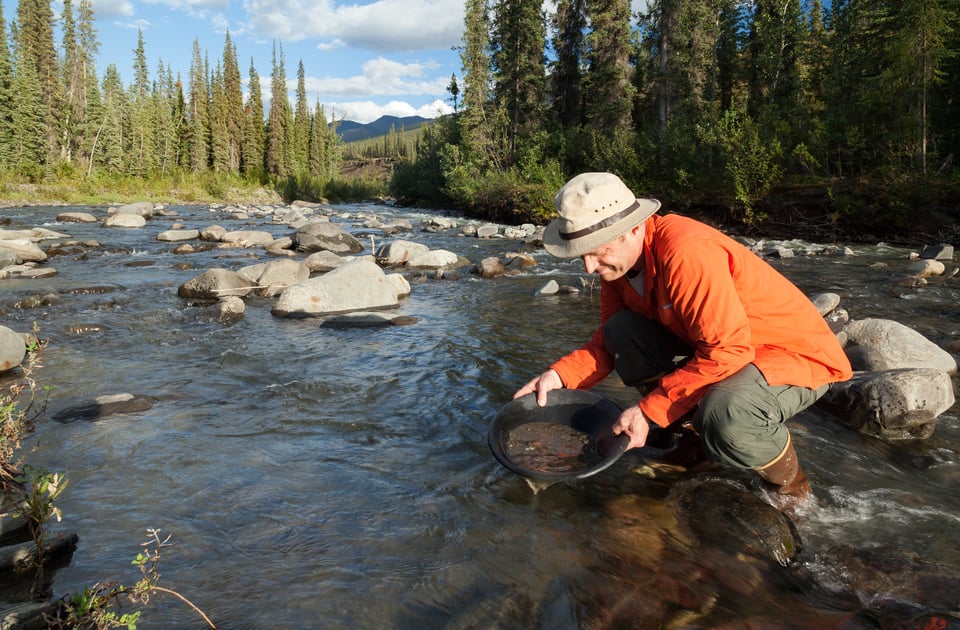
The price of gold has soared this year, reaching $4,000 an ounce. So what’s also on the rise? Prospecting!
Apparently a new generation of Americans are heading out to the hills and creeks in hopes of finding a life-changingly large nugget. One is the California welder Mike Hewett, who recently found a chunk of gold “about half the size of his pinkie fingernail” while prospecting in the Mount Shasta forest with a metal detector.
As he told Te-Ping Chen of the Wall Street Journal (gift link) …
“I was jumping all around like you see in cartoons and stuff,” the 50-year-old said. The nugget, which he later had weighed, wasn’t exactly life-changing. “It was worth $175,” he said. “But then again, it was just sitting out there to be taken.”
Across the country, a modern-day gold rush is under way. People on social media brandish gold-flecked pans and nuggets while showing off their equipment, ranging from old-fashioned picks to gold-separating sluice boxes. Others trade tips and pore over maps, determined to figure out which areas could still hide metallic riches.
The dream of stumbling on a motherlode might be far-fetched, but with gold prices reaching $4,000 an ounce, it’s a tantalizing one.
“The whole way I’m driving out, I’m thinking I’m going to pull out this freaking $100,000 nugget,” said Hewlett.
Apparently gold-panning lessons are selling out. Part of the reason for this new rush is — bien sur — the effect of gold-panning influencers, some of whom have millions of followers. But it’s partly also about the sheer romance of finding stuff that’s just lying around in nature that’s worth money:
He said the thrill of that first gold find in the wild can’t be beat, and keeps people coming back. “It’s like a heroin addiction,” he said.
13) 🎱 Mapping every pool table in NYC

For the last year and a half, Dan Tran has been obsessively mapping the location of every pool table in New York City. He’s found 411 so far, and you can see his map online here at Pooltables.nyc …
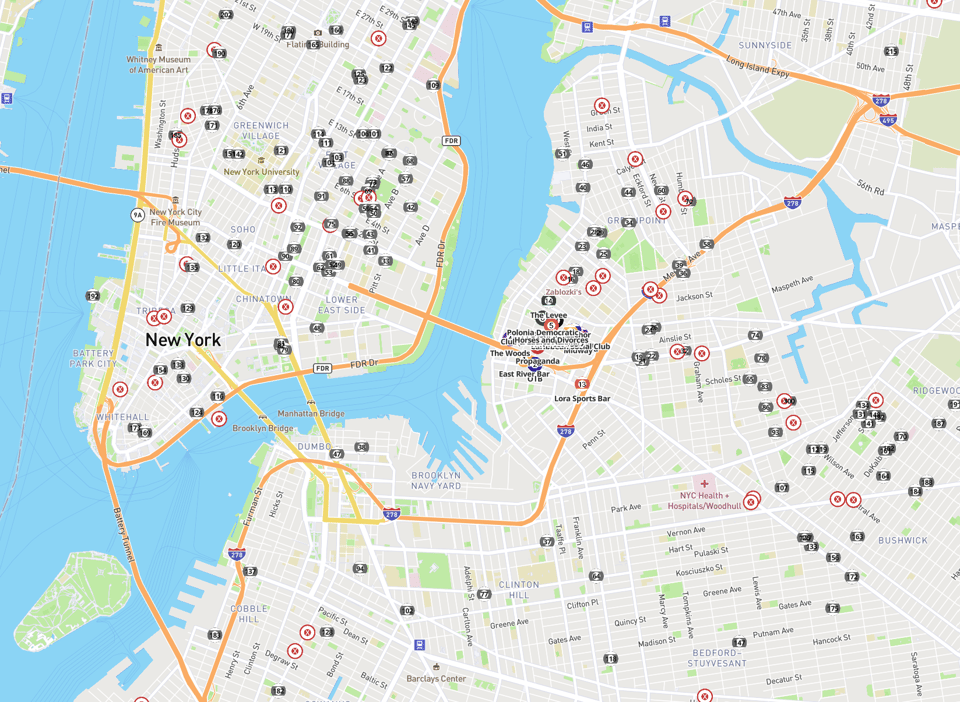
What are some of the strangest locations where you've logged a pool table?
Obviously if it's a bar or a pool hall, that makes sense to include, but then there are things like old-school social clubs. There's Banatul, which is a Serbian-Romanian social club on Menahan in Ridgewood. I just walked by with a bunch of friends one night, looked in, saw a pool table, and the guy out front was like, "Y'all wanna come in?" They sell drinks, but it's very much a club, same as an Elks Lodge, Moose Lodge, or VFW.
Then there are ones that blur the line, like the pool table in the basement of a Bushwick bodega. And there are private clubs like the New York Athletic Club, which is a really fancy spot on Central Park South. They have a billiards room with snooker tables and full-length pool tables. Those are the ones that seem a little aspirational to me—like I know they're there and it's possible to get in, but where I draw the line is: not your private residence, no amenity buildings. Though there is a pool table in the VIP room of a spa on Wall Street.
Apparently the “pool deserts” of the city — where you can wander for blocks and blocks without encountering a table — are in the Upper East and Upper West Sides, probably because The Rent Is Too Damn High so putting space aside for a table ain’t worth it. The hotspots are out in Williamsburgh, and also this cool tidbit …
Some of the Chinese pool halls out in Flushing are really interesting. I'm not Chinese so I go there and I'm just like, wow, these are some very, very serious old Chinese men here, playing "three-cushion." [Ed. note: It's an older form of billiards with no pockets, where players ricochet shots off each others' balls.]
(BTW, if you’re a New Yorker, consider subscribing to Hellgate; it does amazing local coverage! I subscribed last year and love it.)
14) 📟 Why we rarely “lose” technology

Sci fi is replete with stories of “lost” technologies — i.e. where a story is set in the far future, usually longer after some massive civilizational collapse, where people discover rusting old tech from thousands of years ago that they can not longer fathom, operate, or produce.
Cool story, but … has this ever actually happened? Has there ever been a technology in the past that has vanished, and for which the secrets of its technique are irretrievably lost?
Étienne Fortier-Dubois ponders this question and goes through a couple dozen possibilities from the near and distant past, and concludes that it’s almost unheard of. Even when there’s a tool from the past that was made using some technique that has now been lost, the odds are high that we could replicate it nowadays if we tried.
That said, his list of possibilities is incredibly interesting! And it includes several technological feats of the past that I’d never heard of, like …
The iron pillar of Delhi, in India, may not look like much … but it was erected in the 5th century, under the reign of Chandragupta II, and it still hasn’t rusted, which is rather extraordinary. Scientific analyses have found that it is coated with a thin protective layer of iron hydrogen phosphate hydrate (FePO4-H3PO4-4H2O). We don’t really know how the ancient Indian metallurgists did it, which means it could be an actual lost technology. Or maybe they just got lucky.
Or there’s wootz steel, also fabricated in India, and is …
… a steel alloy with high carbon content that creates cool patterns on its surface: Wootz steel is the material behind Damascus steel, famous throughout the world for making great swords. (The swords were made in Damascus from steel imported from India or Iran.) The production of Damascus steel declined until it completely stopped around 1903 [snip]
Wikipedia says that:
Several modern theories have ventured to explain this decline, including the breakdown of trade routes to supply the needed metals, the lack of trace impurities in the metals, the possible loss of knowledge on the crafting techniques through secrecy and lack of transmission, suppression of the industry in India by the British Raj, or a combination of all the above.
15) 🎙️ A final, sudden-death round of reading material
Tiny vinyl. 🎙️ 1973 version of Wordle, done in BASIC. 🎙️ Anal oxygen absorption. 🎙️ “Death-ball” sponge. 🎙️ Why every movie looks orange and blue. 🎙️ Sad 404 face. 🎙️ Analysis of the storm that sank the Edmund Fitzgerald. 🎙️ Louisina children’s art from Hurricane Katrina. 🎙️ The rise of “balcony solar”. 🎙️ Neanderthal art. 🎙️ Linux running in a browser tab. 🎙️ Minecraft running on a smart lightbulb. 🎙️ Doom running on a satellite. 🎙️ Cool religio-digital art. 🎙️ Making music with a massage gun. 🎙️ It takes only 250 documents to poison an LLM. 🎙️ The etymology of “yclept”. 🎙️ What, exactly, is a moon? 🎙️ In praise of xenomorphs. 🎙️ Like Strava, except for writing. 🎙️ Why LLMs are stuck in Memento. 🎙️ Behold the Motofocker Velocar. 🎙️ Spreadsheets as UI. 🎙️ Power-generating rocking chair. 🎙️ The Internet Starter Kit book from the mid-90s. 🎙️ Zorin, the Linux variant that looks like Windows. 🎙️ Kodak’s secret nuclear device. 🎙️ Conway’s Game of Life, with music. 🎙️ New version of Pascal’s Wager. 🎙️ 3D-printable “Butta Melta”. 🎙️ Why prisons ban fantasy and sci-fi. 🎙️ The most terrifying bike ride you’ll see today. 🎙️ Mind captioning. 🎙️ The people who think roaches are “cute”. 🎙️ The “Killer Shark” videogame from Jaws actually existed. 🎙️ DIY sugar rocket. 🎙️ An octopus plays piano.
CODA ON SOURCING: I read a ton of blogs and sites every day to find this material. A few I relied on this week include Robin Sloan, Strange Company, Link Machine Go, Hackaday, Messy Nessy, Numlock News, the Awesomer, the Morning News, and Mathew Ingram’s “When The Going Gets Weird”; check ‘em out!